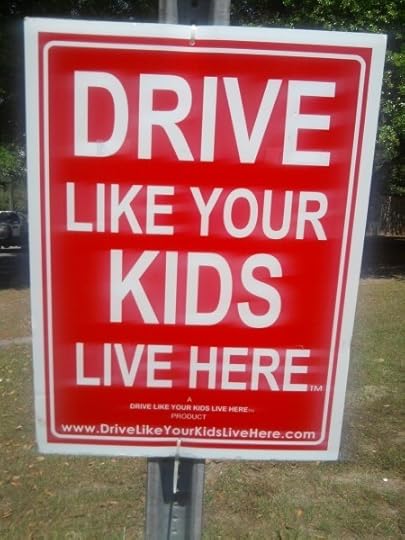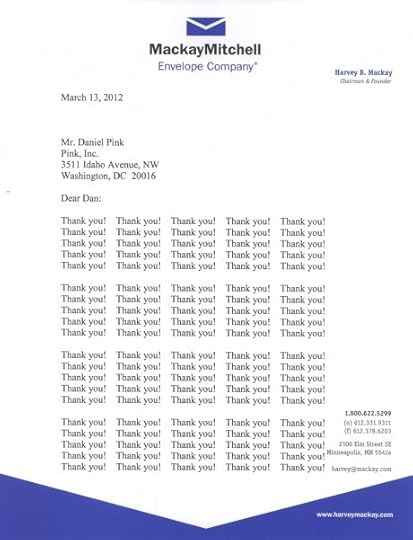Daniel H. Pink's Blog, page 8
April 23, 2012
Factoid of the day: National priorities edition
“As a result of the [tax] code’s growing complexity, Americans spent a total of 7.64 billion hours in 2010 negotiating tax-related paperwork—more than twice the working time of all the elementary school teachers in the U.S.”
(Source: The Week, citing Reason.com)
April 16, 2012
This might be the best 11 minutes you’ll spend today.
Seth flags this short film about this amazing project. Watch it. Seriously.
P.S. Seth also has some interesting thoughts on what this film tells us about the book industry.
April 13, 2012
Textbook example of emotionally intelligent signage
Back in the old days, when an international team of Ph.D. social scientists and veteran graphic designers first conceived the idea of emotionally intelligent signage in a series of secret all-night meetings in my garage*, the term had a particular meaning.
The idea was that signs could be more effective — that is, they were more likely to produce the desired behavior — if they: a) expressed empathy with the viewer; or b) elicited empathy in the viewer. The concept has widened a bit since then, particularly with examples of signs using humor to make their point.
But last week Kathleen Curry sent us a sign that meets the classic, original definition. Driving on Coleman Blvd. in Mount Pleasant, South Carolina, she spotted the sign below. It reminds me of what the town of Needham, Massachusetts, did not too long ago — and it’s apparently part of a national movement.
Hard to say for sure whether this sort of sign will change behavior, but I’m guessing it just might.
* Note: This creation myth, like many others, is somewhat embellished.
April 12, 2012
How to move people with two irrational questions
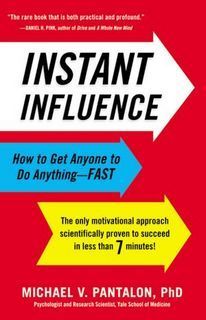 Unless you're a hermit in a cave somewhere (and if so, how are you reading this blog?), you're probably in a position to influence someone in your circle – children, a significant other, your co-workers, your boss – several times a day.
Unless you're a hermit in a cave somewhere (and if so, how are you reading this blog?), you're probably in a position to influence someone in your circle – children, a significant other, your co-workers, your boss – several times a day.
Lately I've been digging into this broad question of how of we move people and I consulted a fascinating book I'd read several months ago titled Instant Influence: How to Get Anyone to Do Anything – Fast! (Buy it at Amazon, BN.com, or IndieBound). The author, Michael Pantalon, is a psychologist research scientist at the Yale School of Medicine. And he's generously agreed to share one of the tips from the book with us. If you get a chance to try this technique, let us know in the Comments section how it worked out for you.
Now here's Dr. Pantalon:
What do you say when someone at work says, "No" to your suggestion? You probably respond with a perfectly rational question like, "Why not?" Unfortunately, I've learned that rational questions are ineffective for motivating resistant people. Instead I've found that irrational questions actually motivate people better.
For example, imagine you're a manager at a major PR firm and one of your reports balks at revising an important part of the next big campaign. Instead of asking rational but ineffective questions, try the following 2 seemingly irrational questions:
1. How ready are you to make the revisions, on a scale from 1 to 10, where 1 means not ready at all and 10 means totally ready?
Make sure she gives you a number. On the rare chance that she says, "1," surprise her by saying, "What would turn it into a 2?" In telling you what it would take for her to become a 2, she reveals what she needs to do before she is able to make the revisions to the campaign. That is what you motivate her to do first.
2. If she picks a number higher than 2, ask, "Why didn't you pick a lower (yes, lower) number?"
Question 1 seems irrational, because you're asking, "How ready are you…?" of a person who just said, "No," which we can assume means not at all ready. However, most resistant people have some motivation that they keep from us. If you ask, "Are you going to take my suggestion, yes or no?" they continue to keep their motivation hidden. But if you ask them the "1-10" question, they're much more likely to reveal their motivation by saying a 2 or a 3, which is far better – you've now moved from a "No" to at least a "Maybe."
Question 2 seems really irrational, perhaps even absurd. It's the opposite of the rational and expected question, "Why aren't you more motivated?" which only breeds more resistance. However, by asking Question 2, you're asking her to defend why your directive to revise the campaign is even the slightest bit important to her (e.g., deep down, she knows getting over her defensiveness around critique is an important career goal) rather than to defend her excuses why she won't do it (e.g., too busy). The answers she gives lead her to rehearse the positive and intrinsic reasons for doing what you asked, which, in turn, dramatically increase the chances that she gets the project done.
April 4, 2012
Next on Office Hours: Jonah Lehrer talks creativity
 Office Hours — our one-of-a-kind radio-ish program — continues its run of great guests on Friday when we host Jonah Lehrer, author of the just released Imagine: How Creativity Works.
Office Hours — our one-of-a-kind radio-ish program — continues its run of great guests on Friday when we host Jonah Lehrer, author of the just released Imagine: How Creativity Works.
As many of you know, Jonah is a prolific writer on science and culture for Wired, The New Yorker, and the Wall Street Journal. His new book, about the inner workings of creativity, will debut Sunday at #1 on the New York Times bestseller list.
Join us Friday April 6 at 1pm, EDT to talk about the myth of muses, whether some people are more naturally creative than others, when to push through a problem and when to take a hot shower, and much more.
You can listen in live, and ask Jonah a question, by calling (703) 344-2171 at the appointed day and time — and entering this passcode: 203373.
For those who haven't caught the bug that's sweeping the nation like Legionnaire's Disease, Office Hours is our new approach to smart listening. Think of it as Car Talk . . . for the human engine. Once a month, I open up the phone lines and guests like Jim Collins, Seth Godin, and Susan Cain answer your questions about work, business, and life. If you've missed an episode, you can catch up on iTunes.
That's April 6 at 1pm EDT. Ask Jonah Lehrer anything you want. Only on Office Hours.
April 2, 2012
50 centuries of work = 5 important lessons
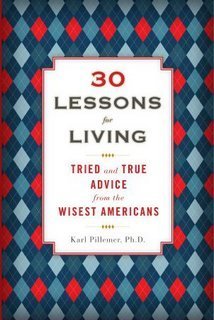 Cornell professor Karl Pillemer admits he's an advice junkie. Yet even amid the groaning self-help shelves at his local bookstore, he felt something was missing.
Cornell professor Karl Pillemer admits he's an advice junkie. Yet even amid the groaning self-help shelves at his local bookstore, he felt something was missing.
As he asks in 30 Lessons for Living: Tried and True Advice from the Wisest Americans (Amazon, BN.com, IndieBound), "Why, if we have so many professional advice givers, are so many people still so unhappy? The overflowing feast of advice seems to have left a lot of people pushing back from the table hungry."
He began looking for "advice that is based in lived reality, has stood the test of time, and offers a chance of genuinely helping us make the most of our lives," and found it right under his nose, in the collective wisdom of the very people he had been studying his entire career — senior citizens.
For five years, Pillemer surveyed and interviewed the savviest seniors he could find – over a thousand of them – and from this material distilled thirty pithy lessons. I highlighted 30 Lessons for Living in a recent newsletter as one of the best books I've read so far this year.
The book includes a chapter of career advice based on the wisdom gleaned from his subjects' 50,000 years of work experience. (Try fitting that on a resume!) Here's what Pillemer calls the "refrigerator list" of the five lessons gleaned from all that experience:
1. Choose a career for the intrinsic rewards, not the financial ones.
2. Don't give up on looking for a job that makes you happy.
3. Make the most of a bad job.
4. Emotional intelligence trumps every other kind.
5. Everyone needs autonomy.
What intrigues me about this list is that it accords so well with what science tells us about motivation and happiness. But then, your grandparents could have told you that.
March 27, 2012
2 signs to help you make a choice
Our mail bag of emotionally intelligent signage this month shows the many ways businesses are deploying signs to influence people's choices. Here are two examples that take very different approaches.
In Norway, Coca-Cola used the two ways to exit a subway station to demonstrate the differences between two drinks it was promoting at local McDonald's restaurants. Drink regular Coke — and you can take the stairs to burn off some of the calories you've consumed. Drink Coca-Cola Light — and you can ride the escalators guilt-free:
Meanwhile, Paul Copcutt spotted these adjoining signs in southern Ontario, in which dueling real estate agents try to persuade prospective buyers which telephone number to call:
March 22, 2012
3 tips for TED speakers (and other talkers)
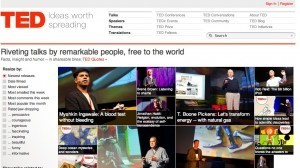 Okay, so yeah. TED is amazing. It's a culture-shaping, era-defining, not entirely uncontroversial extravapalooza that has earned the mind share, eyeballs, and admiration of tens of millions of global citizens. I had a chance to do a TED Talk a few years ago. And last year, my pal Bruno Giussani, one of TED's impresarios, asked me to write up some advice for future speakers.
Okay, so yeah. TED is amazing. It's a culture-shaping, era-defining, not entirely uncontroversial extravapalooza that has earned the mind share, eyeballs, and admiration of tens of millions of global citizens. I had a chance to do a TED Talk a few years ago. And last year, my pal Bruno Giussani, one of TED's impresarios, asked me to write up some advice for future speakers.
I stumbled across that advice the other day — and decided to repurpose it on the Pink Blog in the hopes it will help the legions of TEDx speakers and anyone else trying to move others by standing and delivering.
Here are my three key tips.
1. Prepare . . . but not too much.
These days, very few TED speakers arrive unprepared and just try to wing their presentations. That's great. Preparing is a sign of respect for your audience — and the only way to wrangle your ideas inside an18- or 9-minute fence. But lately I've seen a handful of people who were too prepared and too rehearsed. Their presentations were so heavily shellacked that they seemed inauthentic; their ideas suffocated under all that varnish. Remember: Human beings, despite their imperfections (and sometimes because of their imperfections), are far more persuasive than expertly-tuned presentation robots.
2. Say something important.
There's a big difference between saying some important things and saying something important. Your goal isn't to demonstrate how much you know or to catalog your many insights, but to leave the audience with one idea to ponder — or better, one step to take. When people hear some important things, their heads nod. When they hear something important, their souls stir, their brains engage, and their bodies prepare to act.
3. Say it like yourself.
Don't mimic someone else's style or conform to what you think is a particular "TED way" of presenting. That's boring, banal, and backward. Don't try to be the next Ken Robinson or the next Jill Bolte Taylor. Be the first you.
March 21, 2012
600 ways to say thank you
Earlier this month, we hosted Harvey Mackay on Office Hours. Last week, I received a thank-you note that was memorable — and in its own Godinesque way, remarkable. You can read all five pages here, but the image below should give you the gist.
Some of you might not dig this particular approach. But it's a great reminder that we have more opportunities to stand out from the crowd than we realize.
March 14, 2012
My Favorite Tools: Ginormous Stickies
Drumroll, please.
We've got a brand-new video feature here on the PinkBlog. Think of it as the baby sibling of Pink's Travel Tips.
The first episode — 173 seconds of pure viewing pleasure — is below.

